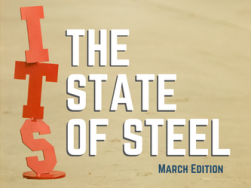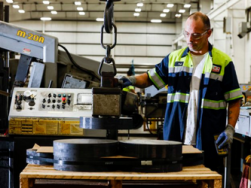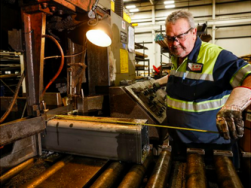State of Steel - March 2023
Pricing - Steel prices begin to climb!
Structural steel pricing is on the rise again. After 7 months of mill decreases, we have now seen 4 straight months of increases for a total of $310/ton. For months, structural tubing has been a highly competitive marketplace. Look for that price competitiveness to flip as inventories get replenished with higher-priced inventories. Look to page 2 for a detailed graph of all structural tube increases or decreases since 2022.
With structural tubing on the rise, mechanical tube pricing continues to remain elevated. Lead times do appear to have shortened in recent months as the mills have begun to catch up on their bookings. Depending on the mill, lead times range from April to July. Due to weak imports and limited producers, pricing looks to remain somewhat high. Most DOM, HRS and CDS prices are remaining flat but smaller tonnage (<10,000 lbs. per size) is seeing an increase. Contract pricing has seen several increases due to continued inflationary pressures and the necessity to assure the sustainability of individual mills. No DOM Scrap Surcharge for the month of March 2023. DOM Fuel Surcharges dropped from 43.5% to 41% for the month of March. Reference page 2 for a graph of price adjustments since 2021 (it went up then and hasn’t come down).
The CRU index (below chart) came in at $908/ton this week. Last week it was $852/ton. Week-over-week change was $56/ton. The anticipation is that the price could go up as high as $1,100 per ton due to a large demand from the automotive industry. We have now seen CRU increases since the beginning of the year. Hot-rolled coil prices in the US Midwest surpassed $50 per hundredweight for the first time in more than eight months, with mills reportedly holding firm on recent price increases despite sources largely viewing these hikes as excessive and unjustifiable. Market pundits were frustrated and bewildered by recent price increase announcements from the mills, more specifically Cleveland-Cliffs’ new base price of $55 per cwt, but also the $50 per cwt announcements from other producers.



Cast Iron Pricing
There have not been any base price increases on cast iron since April 1st of 2022. Dura-Bar’s surcharges appear to have hit bottom in December and have now seen increases over the last 3 months in a row. The above chart details the Dura-Bar surcharges over the last year or so.

Scrap & Steel Inputs
Ahead of the March scrap buy week, market participants currently expect obsolete scrap prices will increase by $40-$60/ton from February levels. If scrap prices do increase, this will mark the fourth consecutive month of increases. (Source: SMU)
Metal Production
In the week ended February 25, US raw steel production increased 1.2% week-over-week to 1,674,000 million tons (-4.6% YoY). US capacity utilization was 73.2% vs 80.3% last year. This marks 33 consecutive weeks where capacity utilization has been below 80%. Year-to-date production is 13,100,000 million tons down 6.1% year-over-year from 13,854,000 million tons last year. (Source: AISI) Despite increasing imports by more than 18% in January 2023 compared to the previous month, the United States is not getting out of its ferrous shortage. Now add to this several outages due to maintenance at US flat steel mills. The shutdowns from March to May are expected to cost a production volume of more than 300,000 metric tons. In the past few days, prices for US HRC had already risen to more than $1,000 per ton. (Source: SteelNews.biz)
Lead Times
Understanding lead times for steel products is important to every participant in the supply chain. Lead times for steel products are as follows (as of 03/07/23):
Average HRC lead times increased significantly last week to 7.8 weeks, which is the highest level since September 2021. Other product lead times also increased significantly with CRC lead times at 7.7 weeks, HDG lead times at 8.1 weeks, and plate lead times at 7.2 weeks. (Source: Platts)
DOM Tubing lead times continue to be long but have shortened slightly and are now anywhere from 10 to 25 weeks. HRS and CDS tubing are substantially longer (15-30 weeks) due to a lack of steel tube hollows, demand, contract business, and labor shortages.
Structural Tubing mill lead times are shortened and run approximately 2-4 weeks upon receipt of the order. Common sizes we can get sooner for now. This may change due to rising prices.
Dura-Bar Continuous Cast Iron mill lead times are approximately 2-4 weeks depending on size, grade, and finish. If it’s a large bar, special grade, size, or shape then the lead time could be considerably longer.
Oil & Gas Industry
The US rig count decreased 0.9% week-over-week to 753 rigs as of 2/24. The rig count is up 15.8% year-over-year. (Source: Baker Hughes) Brent Crude oil price per barrel of oil sits at $82.31 as of 3/07/23. That amounts to a 3.2% decrease from 1 month ago.
Imports/Exports
The US government will impose a 200% tariff on aluminum products of Russian origin starting on March 10. Additionally, starting on April 10, a 200% ad valorem tariff will be applied to products that contain any amount of primary aluminum used in the manufacturing of aluminum products that are smelted or cast in Russia. The US government will also raise tariffs on Russian pig iron, scrap, and DRI up to 70%. These tariffs will take effect on April 1. Prior to the war, Russia and Ukraine accounted for approximately 67% of US pig iron requirements. (Source: SMU)

Economic Factors
The FED raised short-term interest rates to 4.50% ꟷ 4.75% on February 1st, the highest interest rates have been since October 2007, as part of an ongoing effort to decrease inflationary pressures. The increase marked the 8th straight FED meeting with a rate hike but was the smallest increase since March 2022. FED Chairman Jerome Powell indicated that while inflation data had been positive over the last 6 months, the FED will need substantially more evidence to be confident that inflation is on a sustained path downward. The current FED funds rate expectation for the end of 2023 is 4.90% ꟷ 5.60%
The Consumer Price Index (‘CPI’) increased 0.5% MoM in January and 6.4% YoY, above estimates of 0.4% MoM and 6.2% YoY. Core CPI rose 0.4% for the month and 5.6% for the year, against expectations of 0.4% and 5.5%, respectively. Average hourly earnings experienced an increase of 0.3% MoM and 4.4% YoY, indicating wage growth has continued to lag inflation.
Gross domestic product (‘GDP’) in the U.S. increased by 2.9% in the 4Q of 2022, above analyst expectations of 2.6%, contributing to an increase of 2.1% for the full year of 2022. The increase in GDP was attributable, in part, to a 2.1% increase in consumer spending, lower than the 2.3% expected increase, highlighting that personal spending is being negatively affected by inflation. Additionally, government spending increased by 6.2% and private inventories increased by 1.5%, while residential fixed investment fell by 26.7%.
The ISM Services Purchasing Managers’ Index (‘PMI’) unexpectedly jumped to 55.2 in January from a multi-year low of 49.2 in December 2022. The increase was supported by higher spending on services, as interest rates have disincentivized the purchase of goods, which are typically bought on credit.
(Source: Wall Street Journal, Fed. Reserve, Bloomberg)
Employment / Hiring
Approximately 0.190 million Americans filed for unemployment insurance last week. This was better than economists’ expectations of 0.195 million claims and slightly better than last week’s unrevised claims number of approximately 0.192 million claims. Continuing claims also decreased during the week ending February 18 (continuing claims have a week lag in terms of reporting) and stand at approximately 1.655 million continuing claims. (Source: Reuters)






